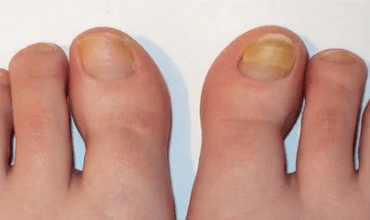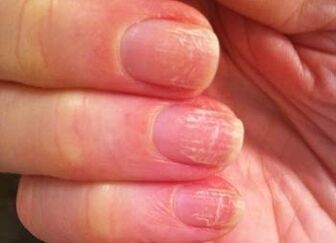
Mycoses, called fungal diseases in everyday life, have a contagious nature and can easily be transferred with an infected person, an animal or an object.
As soon as the mushroom searches on the skin or nail plate, it immediately begins to eat tissue on which it appeared, and gradually settles more and more areas.With its enzymes, the mushroom keratin, which is part of the tissue of the skin, hair and nails, decomposes them.
Nail mycoses in the early stages differ only in a less noticeable manifestation.However, the disease is homogeneous during the entire period of the course and the basis of the treatment used.
How the nail fungus begins: symptoms and photos
The beginning of nail mycosis cannot always be seen by chance because its manifestations can be insignificant.
The possible symptoms of this disease are as follows:
- Change the color of infected areas, often yellowed;
- The disappearance of the gloss of nails;
- the appearance of embossed stains, dots or strips on the nails;
- Thickening, shaft, fragility or peeling of infected areas;
- partly destruction of the nail along the edges and the skin above the nail;
- Itching or pain during infection;
- An unpleasant smell of nails.
The listed phenomena can be both symptoms of mycosis and a consequence of other factors, for example the following:
- Lack of vitamins and minerals;
- Collection of dead skin or dirt;
- Injuries;
- Take some drugs;
- Non -infectious diseases: diabetes, psoriasis, eczema.
Therefore, a laboratory analysis of the affected fragment of the nail plate is required for a precise diagnosis of mycosis even in the presence of symptoms.
Symptoms of the initial wing of nails on the hands: Photo

Nail mycosis in your hands is somewhat less common than on the legs.
His manifestations are the same:
- Stink;
- Itching and pain;
- Atrophy of the nail plate and the skin on it;
- Change of shape and color of the nail plate;
- Loss with the nails of the gloss and a change in their color.
The same symptoms can indicate the following factors:
- Improper nutrition
- Long contact with cleaning agents or chemical reagents
- Take certain drugs
- Some diseases are not infectious.
Methods for the treatment of the starting fungus of the nail
It is necessary to treat fungal infections, since this not only spoils the appearance of the hands or feet, but also leads to an impairment of immunity.As a result, people with mushrooms on nails are more susceptible to colds, influenza and other infectious diseases.
Any possibility of treating nail mycosis must necessarily include measures to prevent a RE function.With affected tissues, the mushroom falls on clothing, shoes and other objects that the patient touches with his fingers or legs.
Therefore, the following rules must be followed:
- Infected shoes used before the start of treatment treat with special means or throw away.
- Before the full recovery, wear cotton socks.
- Do not use slippers, except those that are easy to wash (with a smooth inner surface).
- Change socks and gloves to clean them every day and wash at high temperature and iron.
- It is advisable to treat the shoes throughout the treatment with ultraviolets antifungals.
According to representatives of professional medicine, the myos of nails also require nails in the initial phase, primarily systemic treatment and the exterior in the second.The selection of the drugs is carried out depending on the type of existing mushroom.Laboratory tests can determine it.
- Systemic anti -inflam ingredients or anti -crowds.They accumulate in the nails and horn shells of the skin.The active components of the medicines destroy the fungus in cells and destroy their membrane or stop the synthesis of the substances with which they feed them.As a result, the mushroom dies.The treatment should take at least 3 months according to the following system: a week of approval, a three -week break;So repeat.After that, the medication will be present in the tissues affected by the mushroom for another six months.Thus, a healthy nail has time to grow, and the mushroom does not apply.The remaining treatment methods are used in addition to systemic therapy.The use of only local exposure methods can heal the infection for some time, in this case there is a risk of relapse.
- AntiMyotika of local use.These drugs will soften to the consistency of plastic nails.This effect enables you to easily remove the nails affected by the mushroom, to accelerate the growth of the new nail and to increase the effectiveness of systemic drugs.Antimyotika are made in the form of paints or ointments.The affected nails are covered with paint and the ordinary cosmetic paint is applied at the top.
- Medical pedicure.This method is the removal of fabric fabric, which are affected by a mushroom and a soft grinding of nails and feet with a special tool with many nozzles.The procedure takes 15 minutes to 2 hours and is carried out 1 to 2 times a month.The duration of treatment is 3 months to one year.The medical pedicure takes place in specialized offices.It not only treats infection, but also improves the appearance of the nails.They look much better after the first procedure.And the signs of recovery can be seen in the first 3 weeks of treatment.
- Ozonotherapy.The introduction of ozone in soft parts near nails reduces inflammation in them and increases local immunity.The course of treatment is at least 10 procedures that take up to 20 minutes each.They are kept 1-2 times a week.
- Traditional medicineOffers the following method for the treatment of nail fungi.The following episode of actions must be carried out at least 3 months or up to a complete recovery every day.In the evening before going to bed, they dampen their legs or arms (depending on the position of the infection) in a solution of drinking saton with a temperature of 50 degrees.Apply cotton wool on every nail of the affected limb, well saturated with hydrogen peroxide or apple cider vinegar.Close the foot (brushes) with a plastic wool with cellophane or glue it with one stain and go to bed.Cut the nails as usual during the entire treatment time as usual.
prevention
Sources of infection with mushrooms are:
- Public places where you go without shoes: bathrooms, saunas, shower, sports halls, beaches;
- Public items: shoes (mostly slippers), gloves (for example boxing);
- Carpets, mostly in bathrooms;
- Animals, including domestic and wool that have fallen from them;
- Floor.
In order to minimize the likelihood of infection, it is necessary to observe hygiene rules:
- Avoid contacts with sources of infection, especially with shared shoes and clothing, if possible
- Don't wear tight shoes
- Apply ultraviolet antifungals for shoes in living together with a person with mycosis.
You should know that mushrooms can be brought to life in a dried state after several months.
Risk factors that are not amazed are inheritance and slow nail growth.The fungus is easier to spread through a slowly growing nail.The growth rate decreases with age.
The immunity of this disease does not play a significant role, since it is much lower in the area of nails than in most body systems.
Professional medicine successfully treats mycoses, both in the early stages and afterwards.However, it is not possible to get rid of this disease without addressing a specialist.



























